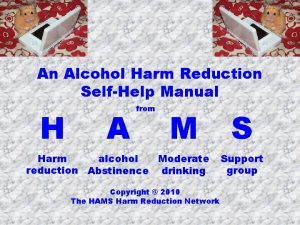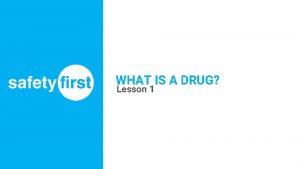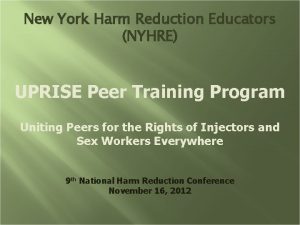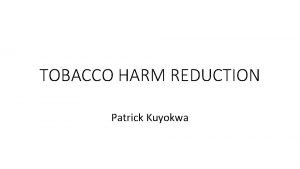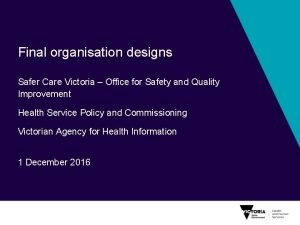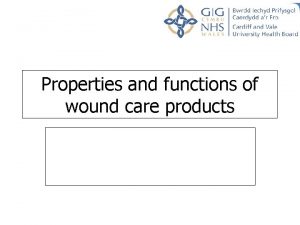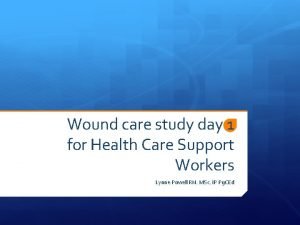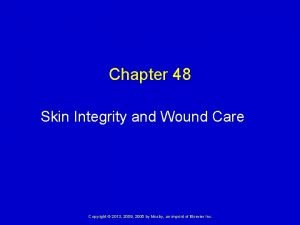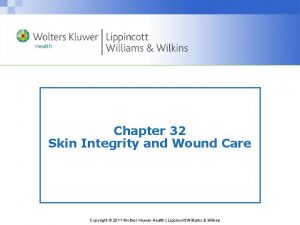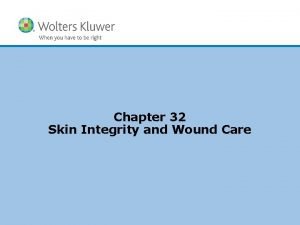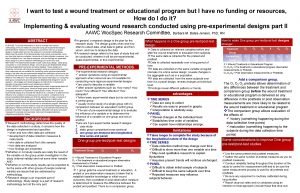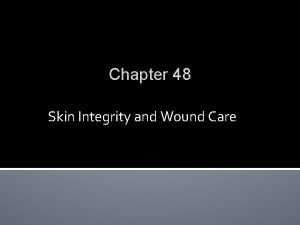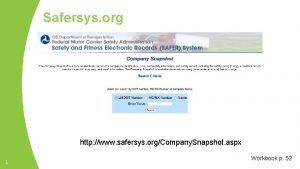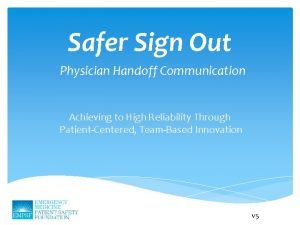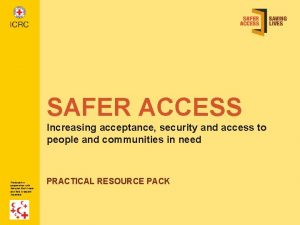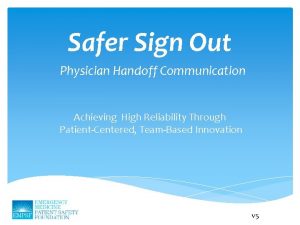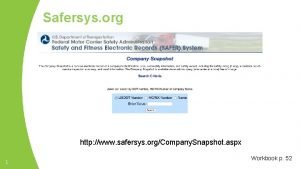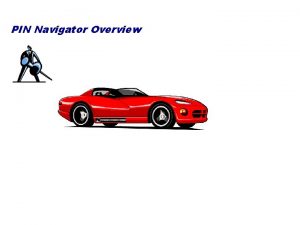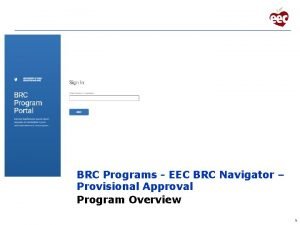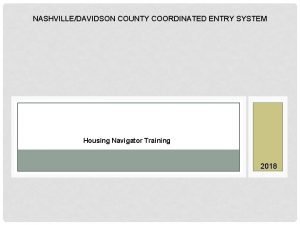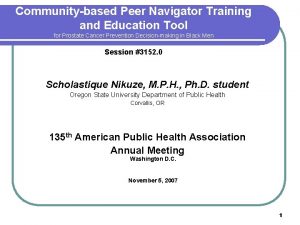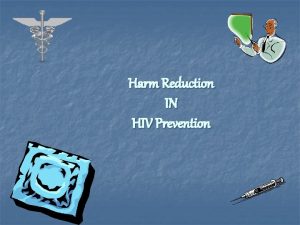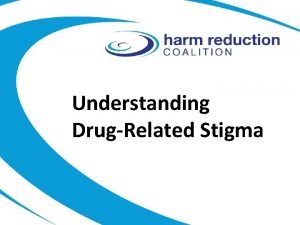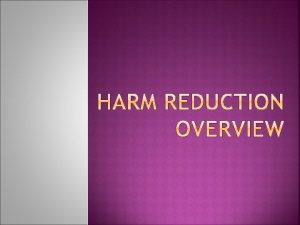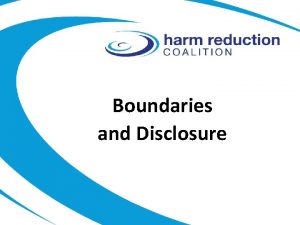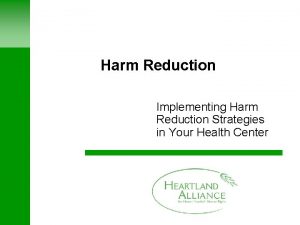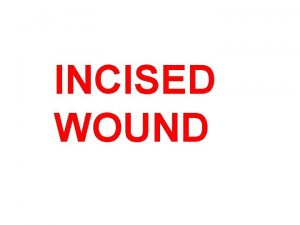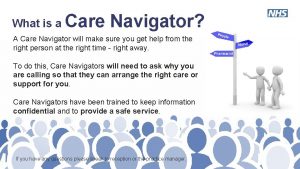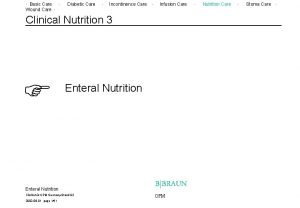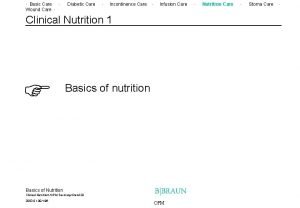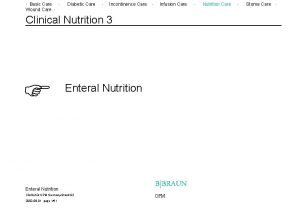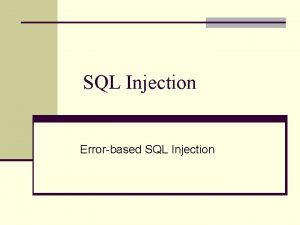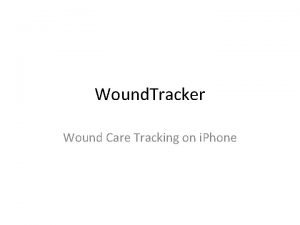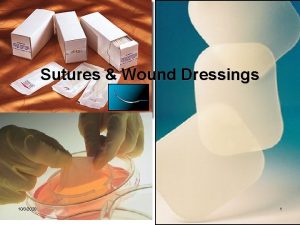Safer Injection Wound Care HIV Harm Reduction Navigator













































































- Slides: 77

Safer Injection & Wound Care

HIV Harm Reduction Navigator Training • Commissioned by NYC DOH National Capacity Building Program for Health Departments and CBOs who have outreach staff and peers providing prevention services for people who use drugs. • Particular focus on PWID and health care issues. • Materials are drawn from HRC’s long experience and other Harm Reduction program peer training programs. You are experts in the field no matter how long you have been doing outreach. Everyone brings relevant experiences & perspectives to this work.

1. Workshop Overview

Group Agreements • Step up, Step Back • Non-Judgment • Use “I” Statements • Agree to disagree • Confidentiality • WAIT/PUSH/ELMO

Training Objectives By the end of this training you will be able to: 1. Recognize safer injection supplies and equipment needed to prevent disease and infection. 2. Identify factors related to injecting drugs. 3. Recall common wounds and infections associated with injection drug use. 4. Provide harm reduction messages tailored to PWID’s unique circumstances.

Agenda Safer Injection & Wound Care 1 Workshop Overview 2 Supplies & Equipment Break 3 Factors to Injecting 4 Infections and Wound Care 5 Work With PWIDs More Effectively 6 Closing & Evaluations

Glossary PWID—People Who Inject Drugs PWUD—People Who Use Drugs PLWHA—People Living with HIV/AIDS SUDs—Substance Use Disorders SAS – Syringe Access Services SEP – Syringe Exchange Program AOD – Alcohol & Other Drugs

• Sexual Orientation >> to whom we are sexually attracted • Gender Identity >> sense of self as male or female, neither or both • LGBTQI Lesbian, Gay, Bisexual, Transgender, Transsexual, Two Spirited, Questioning, Intersex

BRAINSTORM: What are Potential Harms of Injecting?

Potential Harms of Injecting o o o Exposure to HIV Exposure to viral hepatitis Soft tissue infections (abscesses, cellulitis) Vein damage Overdose/Over. Ramp Accidental death Damage to circulatory system, loss of limbs, and tissue Stigma Jail Inability/Difficulty to enjoy getting high in other ways For some people, injecting makes a difference on how they manage their drug use

2. Supplies and Equipment • • • Needles & Syringes Cookers Cotton Sterile water Tourniquet Alcohol pad Band aid, Gauze Bleach Ascorbic acid

VIDEO “Safer Injection Demo” Video provided by CATIE (2008)

Needles and Syringes Injecting Advice Blog, Nigel Brunsdon “If you are injecting, the best needle to use is the shortest, thinnest one that will reach the site and enable you to inject without it breaking. ”

Anatomy of a Syringe


Hierarchy of Syringe Use Safest 1. Use a new and sterile syringe every time 2. Use your own syringe if you have to re-use 3. Rinse syringe with bleach + water if you share 4. Rinse it with water if there is no bleach Less safe

Other Injecting Supplies Cookers (Caps) • • Used to mix up drug solution, put drugs into or pull out Blood in used cookers can transmit Hep C Contaminated water, cotton, rig, can get blood in cooker Best if deep and flat-bottomed to minimize spilling

Cottons (Filters) • Used to filter impurities in the drug • Use %100 cotton: Q-tips, cotton balls and pellets • Avoid cigarette filters, they have tiny bits of glass/plastic

Sterile Water • Water used for injection can easily be contaminated • People need water to 1) dissolve or cook the drug, 2) flush out or rinse syringe & needle after using

Hierarchy of Water Source Safest Ø Use sterile water from vial Ø Use water after boiling 10 min Ø Use cold water from tap or bottled water Less safe Ø Use water from toilet but PULL FROM TANK, then DISCARD in BOWL Ø Avoid water from puddles or another stagnant source

Tourniquet (Ties) • Used to help identify veins • Release before injecting • Ideally non-absorbent w. some give in it • Should be long enough to tie own arm and release w. mouth and wide enough not to cut into skin

Alcohol pads • • • Used to clean skin before injecting Wipe in one direction Do not use after injecting! Avoid swabbing puncture Use to clean fingers Band Aids Used to cover injection sites/puncture wounds Gauze Used to cover injection sites/puncture wounds

Bleach and Water Rinsing Technique • Use cold water • Pull water in syringe and flush 1 x • Pull bleach in and flush 1 x • Use new water to pull in AGAIN and flush 1 x

Ascorbic Acid/Powdered Citric • Used to help dissolve crack, pills, and other solid drugs • Avoid using vinegar or lemon juice Antibacterial ointment • Used after minor wound or puncture closes up or is dry

Sharps Containers • Proper disposal for used sharps • Durable, puncture-proof plastic container • With a secure lid • Medical-issued is great • Home options: q Liquid detergent bottle q Milk jug q Soda bottle

ACTIVITY: Injection Puzzles

BREAK

3. Factors to Injecting

“Go with what you know” Using the wrong gauge • Most people don’t realize how many veins there are to choose from • Most people don’t rotate veins and tend to stick to the same ones they usually inject • Type of substance • Route of administration • How many times it takes to find a vein Stressful environment • Unsanitary conditions can cause location sites to become infected • Difficulty to steady the hands and take time to find veins and inject with less risk Changing Priorities • Regardless of intentions, person’s behavior may be controlled by how sick they are feeling

Not drinking enough water Sodium Simple sugars Caffeine Tourniquet use • Dehydration conserves water • Veins need water to stay healthy and plump • Water is retained between muscle and skin obscuring veins • Sodium or Salt increases water retention • Sugar lessens body’s ability to expel sodium • Caffeine contributes to dehydration • A tie with no “give” can damage vein from the pressure • Tying off too tight or too long can cut off circulation

Safer Injection Process

Tips for Finding Veins • Use a tourniquet • Drink lots of water • Don’t smoke beforehand • Use warm compress • Switch-up where you inject • Exercise does help • Breathe • Avoid caffeine 20 min. beforehand

Injection Process Find the safest, cleanest, and best well-lit spot possible that has a water source. 1. Wash your hands and prep the area 2. Cook drugs and use a filter 3. Find a vein, use a tourniquet 4. Bevel up and insert and register (flag) 5. Release the tie 6. Inject some drug solution, test strength & effect 7. “Taste” if its okay (not too strong) before doing more

What steps would I take to reduce contamination in this process?

Hand Washing Clean Hands Save Lives Wash your hands when you can and keep your Foto: CDC/Amanda Mills fingers clean!

Bevel up!

Types of Injecting Intravenous (IV): Into a vein Intramuscular (IM): Into a muscle Subcutaneous (SC): Under the skin, skin popping …Why choose one way over another?

Hierarchy of Injecting Sites Safest Arms Hands Legs Feet Less safe Groin Neck

Other Routes of Administration Snorting : Up the nose Smoking : Through mouth to lungs Swallowing: Mouth to stomach Booty Bumping/Plugging: Rectally inserted

Veins and Arteries Arterie s carry blood away from the heart Veins carry blood to the heart

The Heart A strong, muscular pump (a little larger than a fist) Your heart works as a pump that pushes blood to the organs, tissues, and cells of your body.

Veins Feel Different q Veins should feel like wet spaghetti q Veins feel like a bouncy tube or undercooked pasta q Muscle feel like flat steak q Tendons feel like stretched bungee cord q Arteries have a pulse

Veins Arteries • Vein (Venous) blood should be dark red • Avoid injecting through a pulse! • Tap for vein location • Veins should feel like wet spaghetti • If it hurts, you’re doing it wrong • Arterial blood is bright red *frothy* • Avoid hitting an artery • Syringe resists to inject • Blood might spurt back out • A lot of blood maybe • Pain and Burning sensation • Get help after 2 hours if symptoms worsen LOWER RISK if injected properly HIGH RISK if artery is punctured

If you hit an artery: Apply firm pressure to stop the bleeding At least for 30 min If possible, raise the affected area Lie down Dial 911 for an ambulance if bleeding does not stop Ø Even if bleeding does stop, contact a doctor Ø Ø Ø

Injecting Arms and Hands

Injecting Legs and Feet Veins and Arteries in Feet Veins in Legs

Injecting Neck and Groin Jugular Vein/Carotid Artery Femoral Artery Carotid & Femoral Veins are very close to their Arteries ***Compromising these arteries can result in stroke, brain damage, and death***

Veins & Nerves • Nerves are typically hit when the angle of injection is incorrect (too deep, usually ) • Common symptoms are an electrical pulse feeling that radiates from the injection site down the arm and into (typically) the pinky finger or thumb • Usually resolves itself within a few hours to 3 months (based on severity) • Seek treatment if pain is excruciating and/or: Ø If movement is restricted Ø If a body part or area loses sensation Ø Any other suspicious symptoms DOI: 10. 1016/j. bjane. 2013. 06. 003 Ramos (2014)

Use an Extra Syringe to Split Drugs Backloading (diagram>>) • Draw up liquid into the back of each syringe after the plunger has been removed • Also called Piggybacking Frontloading • Squirt drug carefully into the front of the other syringe that still has the plunger in it • Need detachable needle type for this

Basic Safer Injection Messages • After injecting apply gentle pressure to the puncture wound with tissue or cotton. • But don’t use alcohol pads after you inject – they stop your blood from clotting, so you bleed more. • Dispose of used syringes in a sharps container or something hard and puncture-proof with a lid like a detergent bottle or milk jug.

Basic Safer Injection Messages • Take control of your own injection. • Hep C is easy to acquire and transmit – only a very small amount of blood is required, and may survive outside the body much longer than HIV. • Dispose of sharps containers at local syringe exchange. • Avoid drawing up from a cooker if someone else has used it.

4. Infections and Wound Care • Wounds may not be at injection site • Often PWIDs do not seek care until the situation has become desperate

ACTIVITY: Abscess Carousel

Contaminated Hit A shot that makes someone sick or causes an abscess as a result of being contaminated. • • • Contaminants in the WATER used to dissolve the drugs Bacteria, fungi, or other microbes from OLD COTTONS Chemicals in a CIGARETE FILTER used to filter a shot Contaminants in the DRUGS themselves NOT WASHING the skin prior to injection

An abscess is Abscess • a swollen infected sore • a painful collection of pus • usually caused by a bacterial infection An abscess • can develop anywhere body • can feel hot • can develop into a hard pusfilled core Foto: Amrith Ra Initial symptoms include redness, swelling, and tenderness

Common causes • Missed hits or shots • Injecting a solution with a lot of particles (ex: pills) • Not cleaning the skin before injecting • Used or un-sterile injecting equipment • Skin popping • Cocaine/Crack injection • Weak immune system

Abscess care: Ø Keep area clean and warm Ø Soak in hot water or use warm compress Ø Elevate Ø Let drain Ø DON’T SQUEEZE Ø Avoid injecting into or next to the abscess Seek Medical Attention If experiencing chills, fever, extreme fatigue or pain on the abscess. This could be a blood infection.

Endocarditis Foto: George Hodan Mills • An infection of the heart lining • Caused by bacteria that entered the bloodstream during injecting • Bacteria builds up and weakens the valves and other parts of the heart

Endocarditis can cause • heart murmur • fever • chest pains • fainting spells • shortness of breath • heart palpitations • death if left untreated Treatable with antibiotics (often IV)

Cotton Fever is: • caused by the bacteria that live in used cotton filters • not caused by injecting cotton fibers • uncomfortable but not usually serious • however, go to the ER if symptoms last longer than 4 hours Symptoms occur soon after injecting: chills, fever, shaking, hot flashes, nausea, headaches Wrap yourself in blanket and ride it out. King County Health Department/Seattle Needle Exchange Brochure, Cotton Facts & Tips

Basic Wound Care for Non-Clinicians

Skin Education RED: healthy tissue YELLOW: slough BLACK: necrotic SMELLY: infection

Start with the basics: Ø Is there dressing available? Ø Can the client care for the wound? Ø What services are available to take care of the wound that the client could access?

Too WET DRY it Too DRY MOISTEN it Too DEEP PACK it* *Have the clinic do this

Changing Wound Dressings q Remove old bandages • Wash hands • Put on gloves if possible • Hold down the skin and gently pull up the tape • Lift corners of dressing • If it sticks, moisten dressing

Clean the wound every time you change the dressing. Foto: CDC/Kimberly Smith, Christine Ford

q Clean Wound • Place towel underneath • Rinse with water, saline water, or salt water Ø DO NOT rinse with peroxide, alcohol, or iodine!!! • Use clean gauze to remove loose debris • Wipe from center of wound outward • Dry surrounding skin by patting it dry

q Check for Signs of Infection • Bad odor or smell • Swelling • Tenderness • Thick pus • Spreading redness around edges

Foto: CDC/James Gathany q Apply New Dressing • Touch only the corners of the dressing • Center it over the wound and seal the edges • Tape the dressing if necessary • No wrinkles

Keep in mind: Ø Use wound dressing only once Ø Keep un-used dressings in original package Ø Store un-used dressings in a clean, dry place Ø Discard or Properly dispose of dressings if they get wet, contaminated, or dirty

5. Work with PWIDs More Effectively

Harm Reduction A holistic approach to working with People Who Inject Drugs As providers, we can be gatekeepers providing more comprehensive care that is: Convenient - Positive - Honest Productive - Client-centered - Pragmatic - Evidence-based - Without Bias

Best Practices: Ø Ø Ø Ø Take cues from the participant Do not interrupt street trade during outreach Active listening is KEY Mindful verbal + non-verbal communication Trust takes time, don’t force it Maintain confidentiality and practice discretion Be honest about what you can’t offer or do

Try Prompt Talk Do you ever need to re-use your needle? Can I leave you with a few more so you don’t have to re-use as often? Can I give you extra cookers? If you re-use do you have enough bleach to rinse them out? Do you have a way to clean out or boil your cookers? Have you ever tried a different sized needle? How do you prefer to shoot or take your drugs? Would you like to take a few different sizes to try?

Reflective Practice: Safer Injection Identify What are some safer injection strategies you can apply to your work now? Any new skills or knowledge? Explain Summarize an idea that is new to you about safer injection (or vein care or wound care) to a colleague. Apply What approaches can you use to engage participants in conversations about ways to improve safer injection habits? How to prevent and care for an abscess?

6. Closing & Evaluations Anonymous Surveys: Put completed surveys in the folder

HRC thanks you for participating in this workshop!
 Harm reduction worksheets
Harm reduction worksheets Hams drinking
Hams drinking Harm reduction strategies
Harm reduction strategies New york harm reduction educators
New york harm reduction educators Harm reduction
Harm reduction Harm reduction programme
Harm reduction programme Safer care victoria
Safer care victoria Primary care navigator
Primary care navigator Torrance memorial wound care center
Torrance memorial wound care center Atruaman
Atruaman Shasta regional wound center
Shasta regional wound center Code of conduct for healthcare support workers
Code of conduct for healthcare support workers Copyright
Copyright Chapter 48 skin integrity and wound care
Chapter 48 skin integrity and wound care Chapter 32 skin integrity and wound care
Chapter 32 skin integrity and wound care Wound care pretest
Wound care pretest Ryb color code wound care
Ryb color code wound care Chapter 48 skin integrity and wound care
Chapter 48 skin integrity and wound care Wound care near freedom
Wound care near freedom Doylestown wound care center
Doylestown wound care center Level of care primary secondary tertiary
Level of care primary secondary tertiary Safersys.org snapshot
Safersys.org snapshot Safer recruitment consortium
Safer recruitment consortium Safer places scheme
Safer places scheme Engineering a safer world
Engineering a safer world Physician sign out
Physician sign out Safer access framework
Safer access framework Safer web mc
Safer web mc Conflict management seminar
Conflict management seminar What are three possible exiting problems?
What are three possible exiting problems? Safer r model
Safer r model Othello summary act 2
Othello summary act 2 It stops here safer pathway
It stops here safer pathway Safer sign out
Safer sign out Entrances to expressways
Entrances to expressways To err is human building a safer health system
To err is human building a safer health system Engineering a safer world
Engineering a safer world Self-driving coalition for safer streets
Self-driving coalition for safer streets Single level inheritance is safer than
Single level inheritance is safer than Safersys snapshot
Safersys snapshot Safer
Safer Pin navigator
Pin navigator Prince henry the navigator ap world history
Prince henry the navigator ap world history Lex aplikant
Lex aplikant Process head
Process head Portfolio navigator
Portfolio navigator Decca navigation system
Decca navigation system System i navigator
System i navigator Henry the navigator
Henry the navigator Oulu campus navigator
Oulu campus navigator Exposure brush photoshop
Exposure brush photoshop Eec provisional
Eec provisional Hmis nashville
Hmis nashville Kuder navigator
Kuder navigator Sgmm navigator
Sgmm navigator Peer navigator training
Peer navigator training Adoddle navigator
Adoddle navigator Navigator discipleship tool
Navigator discipleship tool Flores247 group id
Flores247 group id Aws wind navigator
Aws wind navigator 50001 ready navigator
50001 ready navigator Map of area
Map of area Fpg navigator
Fpg navigator Palette berfungsi untuk
Palette berfungsi untuk Medienkompetenz navigator
Medienkompetenz navigator Prince henry the navigator maps
Prince henry the navigator maps Bbo navigator
Bbo navigator Scalar quantity has
Scalar quantity has 1994 netscape navigator
1994 netscape navigator Informatica powercenter overview
Informatica powercenter overview Nuclide navigator
Nuclide navigator John cabot term dates
John cabot term dates Thomson reuters datastream
Thomson reuters datastream Six images of managing change
Six images of managing change Dbi navigator
Dbi navigator Netscape navigator internet explorer
Netscape navigator internet explorer Lernplannavigator
Lernplannavigator Airport navigator
Airport navigator
